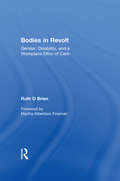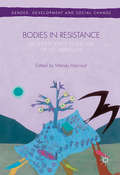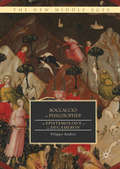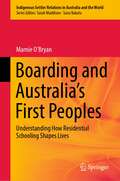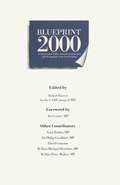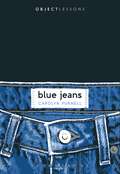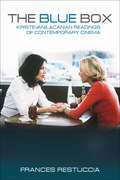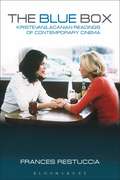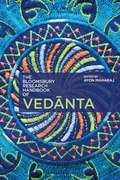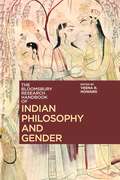- Table View
- List View
Bodies in Revolt: Gender, Disability, and a Workplace Ethic of Care
by Ruth O'BrienBodies in Revolt argues that the Americans with Disabilities Act (ADA) could humanize capitalism by turning employers into care-givers, creating an ethic of care in the workplace. Unlike other feminists, Ruth O'Brien bases her ethics not on benevolence, but rather on self-preservation. She relies on Deleuze's and Guttari's interpretation of Spinoza and Foucault's conception of corporeal resistance to show how a workplace ethic that is neither communitarian nor individualistic can be based upon the rallying cry "one for all and all for one."
Bodies in Resistance: Gender and Sexual Politics in the Age of Neoliberalism (Gender, Development and Social Change)
by Wendy HarcourtAs part of the emerging new research on civic innovation, this book explores how sexual politics and gender relations play out in feminist struggles around body politics in Brazil, Colombia, India, Iran, Mexico, Nepal, Turkey, Nicaragua, as well as in East Africa, Latin America and global institutions and networks. From diverse disciplinary perspectives, the book looks at how feminists are engaged in a complex struggle for democratic power in a neoliberal age and at how resistance is integral to possibilities for change. In making visible resistances to dominant economic and social policies, the book highlights how such struggles are both gendered and gendering bodies. The chapters explore struggles for healthy environments, sexual health and reproductive rights, access to abortion, an end to gender-based violence, the human rights of LGBTIQA persons, the recognition of indigenous territories and all peoples’ rights to care, love and work freely. The book sets out the violence, hopes, contradictions and ways forward in these civic innovations, resistances and connections across the globe.
Bodies for Sale: Ethics and Exploitation in the Human Body Trade
by Stephen WilkinsonBodies for Sale: Ethics and Exploitation in the Human Body Trade explores the philosophical and practical issues raised by activities such as surrogacy and organ trafficking. Stephen Wilkinson asks what is it that makes some commercial uses of the body controversial, whether the arguments against commercial exploitation stand up, and whether legislation outlawing such practices is really justified.In Part One Wilkinson explains and analyses some of the notoriously slippery concepts used in the body commodification debate, including exploitation, harm and consent. In Part Two he focuses on three controversial issues (the buying and selling of human kidneys, commercial surrogacy, and DNA patenting) outlining contemporary regulation and investigating both the moral issues and the arguments for legal prohibition.
Bodies for Sale: Ethics and Exploitation in the Human Body Trade
by Stephen WilkinsonBodies for Sale: Ethics and Exploitation in the Human Body Trade explores the philosophical and practical issues raised by activities such as surrogacy and organ trafficking. Stephen Wilkinson asks what is it that makes some commercial uses of the body controversial, whether the arguments against commercial exploitation stand up, and whether legislation outlawing such practices is really justified.In Part One Wilkinson explains and analyses some of the notoriously slippery concepts used in the body commodification debate, including exploitation, harm and consent. In Part Two he focuses on three controversial issues (the buying and selling of human kidneys, commercial surrogacy, and DNA patenting) outlining contemporary regulation and investigating both the moral issues and the arguments for legal prohibition.
Boccaccio the Philosopher: An Epistemology of the Decameron
by Filippo AndreiThis book explores the tangled relationship between literary production and epistemological foundation as exemplified in one of the masterpieces of Italian literature. Filippo Andrei argues that Giovanni Boccaccio's Decameron has a significant though concealed engagement with philosophy, and that the philosophical implications of its narratives can be understood through an epistemological approach to the text. He analyzes the influence of Dante, Petrarch, Thomas Aquinas, Aristotle, and other classical and medieval thinkers on Boccaccio's attitudes towards ethics and knowledge-seeking. Beyond providing an epistemological reading of the Decameron, this book also evaluates how a theoretical reflection on the nature of rhetoric and poetic imagination can ultimately elicit a theory of knowledge.
Boccaccio the Philosopher: An Epistemology of the Decameron
by Filippo AndreiThis book explores the tangled relationship between literary production and epistemological foundation as exemplified in one of the masterpieces of Italian literature. Filippo Andrei argues that Giovanni Boccaccio's Decameron has a significant though concealed engagement with philosophy, and that the philosophical implications of its narratives can be understood through an epistemological approach to the text. He analyzes the influence of Dante, Petrarch, Thomas Aquinas, Aristotle, and other classical and medieval thinkers on Boccaccio's attitudes towards ethics and knowledge-seeking. Beyond providing an epistemological reading of the Decameron, this book also evaluates how a theoretical reflection on the nature of rhetoric and poetic imagination can ultimately elicit a theory of knowledge.
Bob Dylan: Prophet Without God
by Jeffrey Edward GreenThroughout his career, Bob Dylan has always been more than a musician. Whether as an icon of the social movements of the 1960s, a convert to evangelical Christianity publicly wrestling with his faith, or simply a poet of genius, Dylan has occupied a position of moral leadership for more than half a century. Examining these roles collectively, the award-winning political philosopher Jeffrey Edward Green offers a vision of Dylan as a modern-day prophet, providing an overarching account of the significance of Dylan's political, religious, and ethical ideas. Green suggests Dylan is not a prophet of salvation, but rather a "prophet of diremption." Dylan speaks to the ideals that have animated earlier prophets--social justice, individual freedom, and adherence to God--but breaks from past tradition by testifying to the conflicts between these ideals. By considering Dylan's work across his career, Green shows how the humble folk singer from Minnesota who went on to win the 2016 Nobel Prize in Literature has made novel contributions to the meaning of self-reliance, the quest for rapprochement between the religious and non-religious, and the problem of how ordinary people might operate in a fallen political world.
Boarding and Australia's First Peoples: Understanding How Residential Schooling Shapes Lives (Indigenous-Settler Relations in Australia and the World #3)
by Marnie O’BryanThis book takes us inside the complex lived experience of being a First Nations student in predominantly non-Indigenous schools in Australia. Built around the first-hand narratives of Aboriginal and Torres Strait Islander alumni from across the nation, scholarly analysis is layered with personal accounts and reflections. The result is a wide ranging and longitudinal exploration of the enduring impact of years spent boarding which challenges narrow and exclusively empirical measures currently used to define ‘success’ in education. Used as instruments of repression and assimilation, boarding, or residential, schools have played a long and contentious role throughout the settler-colonial world. In Canada and North America, the full scale of human tragedy associated with residential schools is still being exposed. By contrast, in contemporary Australia, boarding schools are characterised as beacons of opportunity and hope; places of empowerment and, in the best, of cultural restitution. In this work, young people interviewed over a span of seven years reflect, in real time, on the intended and unintended consequences boarding has had in their own lives. They relate expected and dramatically unexpected outcomes. They speak to the long-term benefits of education, and to the intergenerational reach of education policy. This book assists practitioners and policy makers to critically review the structures, policies, and cultural assumptions embedded in the institutions in which they work, to the benefit of First Nations students and their families. It encourages new and collaborative approaches Indigenous education programs.
Blues - Philosophy for Everyone: Thinking Deep About Feeling Low (Philosophy for Everyone #46)
by Fritz AllhoffThe philosophy of the blues From B.B. King to Billie Holiday, Blues music not only sounds good, but has an almost universal appeal in its reflection of the trials and tribulations of everyday life. Its ability to powerfully touch on a range of social and emotional issues is philosophically inspiring, and here, a diverse range of thinkers and musicians offer illuminating essays that make important connections between the human condition and the Blues that will appeal to music lovers and philosophers alike.
Blues - Philosophy for Everyone: Thinking Deep About Feeling Low (Philosophy for Everyone #45)
by Fritz AllhoffThe philosophy of the blues From B.B. King to Billie Holiday, Blues music not only sounds good, but has an almost universal appeal in its reflection of the trials and tribulations of everyday life. Its ability to powerfully touch on a range of social and emotional issues is philosophically inspiring, and here, a diverse range of thinkers and musicians offer illuminating essays that make important connections between the human condition and the Blues that will appeal to music lovers and philosophers alike.
Blueprint 2000
by Jim Lester R. HarveyAn attempt by Conservative MPs to put forward and explain their views regarding the so-called technological revolution. The contributors suggest that government must face the challenge of managing the social consequences of this change or risk social upheaval and misery.
Blue Sky Thoughts: Colour, Consciousness and Reality
by Jaime CarnieWith reference to drug-induced visions and the perceptual capacities of bees, Carnie deconstructs the work of Descartes, Newton and Berkeley to produce a new persepective on the way our senses operate.'All credit to him for building the case for an unfashionable theory, and making the reader think - which is what philosophy is supposed to do' Independent on Sunday. 'I like a writer with a big idea. This lucidly eccentric book offers pregnant evocations of dozing on the beach, or walking through a forest, arguments with Newton or Descartes, and musings on LSD trips...Interesting if true.' Stephen Poole, Guardian
Blue Jeans (Object Lessons)
by Carolyn PurnellObject Lessons is a series of short, beautifully designed books about the hidden lives of ordinary things.Few clothing items are as ubiquitous or casual as blue jeans. Yet, their simplicity is deceptive. Blue jeans are nothing if not an exercise in opposites. Americans have accepted jeans as a symbol of their culture, but today jeans are a global consumer product category. Levi Strauss made blue jeans in the 1870s to withstand the hard work of mining, but denim has since become the epitome of leisure. In the 1950s, celebrities like Marlon Brando transformed the utilitarian clothing of industrial labor into a glamorous statement of youthful rebellion, and now, you can find jeans on chic fashion runways. For some, indigo blue might be the color of freedom, but for workers who have produced the dye, it has often been a color of oppression and tyranny. Blue Jeans considers the versatility of this iconic garment and investigates what makes denim a universal signifier, ready to fit any context, meaning, and body.Object Lessons is published in partnership with an essay series in The Atlantic.
Blue Jeans (Object Lessons)
by Carolyn PurnellObject Lessons is a series of short, beautifully designed books about the hidden lives of ordinary things.Few clothing items are as ubiquitous or casual as blue jeans. Yet, their simplicity is deceptive. Blue jeans are nothing if not an exercise in opposites. Americans have accepted jeans as a symbol of their culture, but today jeans are a global consumer product category. Levi Strauss made blue jeans in the 1870s to withstand the hard work of mining, but denim has since become the epitome of leisure. In the 1950s, celebrities like Marlon Brando transformed the utilitarian clothing of industrial labor into a glamorous statement of youthful rebellion, and now, you can find jeans on chic fashion runways. For some, indigo blue might be the color of freedom, but for workers who have produced the dye, it has often been a color of oppression and tyranny. Blue Jeans considers the versatility of this iconic garment and investigates what makes denim a universal signifier, ready to fit any context, meaning, and body.Object Lessons is published in partnership with an essay series in The Atlantic.
The Blue Box: Kristevan/Lacanian Readings of Contemporary Cinema
by Frances RestucciaInformed by the theory of Julia Kristeva, Frances Restuccia analyzes a variety of contemporary films replete with psychoanalytic subject matter and styles. She examines films that present elaborate fantasies and, through them, prompt the viewer to cut across a crippling fundamental fantasy-by enabling a mapping of his or her private fantasy onto the one being played out on the screen. Such absorption is a function of the semiotic dimension of the film, which offers the spectator an experience of intimacy, negativity, the gaze, and death. Kristeva stresses that cinema has the power to bestow desiring subjectivity as a way of resisting the society of the spectacle through the specular. Through analyses of complex films such as Streitfeld's Female Perversions, Lynch's Mulholland Drive, Almodóvar's Volver, and Haneke's Caché, The Blue Box: Kristevan/Lacanian Readings of Contemporary Film demonstrates Julia Kristeva's concept of the "thought specular," from her fascinating chapter "Fantasy and Cinema" in Intimate Revolt. Kristeva deserves our full attention as a film theorist.
The Blue Box: Kristevan/Lacanian Readings of Contemporary Cinema
by Frances RestucciaInformed by the theory of Julia Kristeva, Frances Restuccia analyzes a variety of contemporary films replete with psychoanalytic subject matter and styles. She examines films that present elaborate fantasies and, through them, prompt the viewer to cut across a crippling fundamental fantasy-by enabling a mapping of his or her private fantasy onto the one being played out on the screen. Such absorption is a function of the semiotic dimension of the film, which offers the spectator an experience of intimacy, negativity, the gaze, and death. Kristeva stresses that cinema has the power to bestow desiring subjectivity as a way of resisting the society of the spectacle through the specular. Through analyses of complex films such as Streitfeld's Female Perversions, Lynch's Mulholland Drive, Almodóvar's Volver, and Haneke's Caché, The Blue Box: Kristevan/Lacanian Readings of Contemporary Film demonstrates Julia Kristeva's concept of the "thought specular," from her fascinating chapter "Fantasy and Cinema" in Intimate Revolt. Kristeva deserves our full attention as a film theorist.
Blue: The History of a Color
by Michel PastoureauA beautifully illustrated visual and cultural history of the color blue throughout the agesBlue has had a long and topsy-turvy history in the Western world. The ancient Greeks scorned it as ugly and barbaric, but most Americans and Europeans now cite it as their favorite color. In this fascinating history, the renowned medievalist Michel Pastoureau traces the changing meanings of blue from its rare appearance in prehistoric art to its international ubiquity today. Any history of color is, above all, a social history. Pastoureau investigates how the ever-changing role of blue in society has been reflected in manuscripts, stained glass, heraldry, clothing, paintings, and popular culture. Beginning with the almost total absence of blue from ancient Western art and language, the story moves to medieval Europe. As people began to associate blue with the Virgin Mary, the color became a powerful element in church decoration and symbolism. Blue gained new favor as a royal color in the twelfth century and became a formidable political and military force during the French Revolution. As blue triumphed in the modern era, new shades were created and blue became the color of romance and the blues. Finally, Pastoureau follows blue into contemporary times, when military clothing gave way to the everyday uniform of blue jeans and blue became the universal and unifying color of the Earth as seen from space.Beautifully illustrated, Blue tells the intriguing story of our favorite color and the cultures that have hated it, loved it, and made it essential to some of our greatest works of art.
Blue: The History of a Color
by Michel PastoureauA beautifully illustrated visual and cultural history of the color blue throughout the agesBlue has had a long and topsy-turvy history in the Western world. The ancient Greeks scorned it as ugly and barbaric, but most Americans and Europeans now cite it as their favorite color. In this fascinating history, the renowned medievalist Michel Pastoureau traces the changing meanings of blue from its rare appearance in prehistoric art to its international ubiquity today. Any history of color is, above all, a social history. Pastoureau investigates how the ever-changing role of blue in society has been reflected in manuscripts, stained glass, heraldry, clothing, paintings, and popular culture. Beginning with the almost total absence of blue from ancient Western art and language, the story moves to medieval Europe. As people began to associate blue with the Virgin Mary, the color became a powerful element in church decoration and symbolism. Blue gained new favor as a royal color in the twelfth century and became a formidable political and military force during the French Revolution. As blue triumphed in the modern era, new shades were created and blue became the color of romance and the blues. Finally, Pastoureau follows blue into contemporary times, when military clothing gave way to the everyday uniform of blue jeans and blue became the universal and unifying color of the Earth as seen from space.Beautifully illustrated, Blue tells the intriguing story of our favorite color and the cultures that have hated it, loved it, and made it essential to some of our greatest works of art.
The Bloomsbury Research Handbook of Vedanta (Bloomsbury Research Handbooks in Asian Philosophy)
by Arindam Chakrabarti Stephen Phillips Francis X. Clooney, S.J. Jeffery D. Long Daniel RavehThis handbook brings together a distinguished team of scholars from philosophy, theology, and religious studies to provide the first in-depth discussion of Vedanta and the many different systems of thought that make up this tradition of Indian philosophy. Emphasizing the historical development of Vedantic thought, it includes chapters on numerous classical Vedantic philosophies as well as the modern Vedantic views of Sri Ramakrishna, Sri Aurobindo, and Romain Rolland. The volume offers careful hermeneutic analyses of how Vedantic texts have been interpreted, and it addresses key issues and debates in Vedanta, including religious diversity, the nature of God, and the possibility of embodied liberation. Venturing into cross-philosophical and cross-cultural territory, it also brings Vedanta into dialogue with Saiva Nondualism as well as contemporary Western analytic philosophy. Highlighting current scholarly controversies and charting new paths of inquiry, this is an indispensable research guide for anyone interested in the past, present, and future of Vedanta and Indian philosophy.
The Bloomsbury Research Handbook of Vedanta (Bloomsbury Research Handbooks in Asian Philosophy)
by Arindam Chakrabarti Stephen Phillips Francis X. Clooney, S.J. Jeffery D. Long Daniel RavehThis handbook brings together a distinguished team of scholars from philosophy, theology, and religious studies to provide the first in-depth discussion of Vedanta and the many different systems of thought that make up this tradition of Indian philosophy. Emphasizing the historical development of Vedantic thought, it includes chapters on numerous classical Vedantic philosophies as well as the modern Vedantic views of Sri Ramakrishna, Sri Aurobindo, and Romain Rolland. The volume offers careful hermeneutic analyses of how Vedantic texts have been interpreted, and it addresses key issues and debates in Vedanta, including religious diversity, the nature of God, and the possibility of embodied liberation. Venturing into cross-philosophical and cross-cultural territory, it also brings Vedanta into dialogue with Saiva Nondualism as well as contemporary Western analytic philosophy. Highlighting current scholarly controversies and charting new paths of inquiry, this is an indispensable research guide for anyone interested in the past, present, and future of Vedanta and Indian philosophy.
The Bloomsbury Research Handbook of Indian Philosophy of Language (Bloomsbury Research Handbooks in Asian Philosophy)
by Alessandro GraheliThe Bloomsbury Research Handbook of Indian Philosophy of Language presents a systematic survey of philosophy of language in the Indian tradition, providing an up-to-date research resource for better understanding the history and future direction of the field. Each chapter addresses a particular philosophical problem from the viewpoint of seminal traditions and specific thinkers. Covering the philosophical insight on language found in the mainstream philosophies of Vyakarana, Mima?sa, Nyaya, Vedanta, Buddhism, and Alankarasastra, the chapters tackle crucial semantic and pragmatic questions such as the relation of the speaker to reality, the use of metalanguage, the distinction between sentences, elliptic statements, and figurative usages, and the impact of textual structures on the philosophical message.Complete with further reading suggestions and an annotated bibliography, this collection makes an important contribution to both Eastern and Western contemporary philosophy of language.
The Bloomsbury Research Handbook of Indian Philosophy of Language (PDF)
by Alessandro GraheliThe Bloomsbury Research Handbook of Indian Philosophy of Language presents a systematic survey of philosophy of language in the Indian tradition, providing an up-to-date research resource for better understanding the history and future direction of the field. Each chapter addresses a particular philosophical problem from the viewpoint of seminal traditions and specific thinkers. Covering the philosophical insight on language found in the mainstream philosophies of Vyakarana, Mima?sa, Nyaya, Vedanta, Buddhism, and Alankarasastra, the chapters tackle crucial semantic and pragmatic questions such as the relation of the speaker to reality, the use of metalanguage, the distinction between sentences, elliptic statements, and figurative usages, and the impact of textual structures on the philosophical message.Complete with further reading suggestions and an annotated bibliography, this collection makes an important contribution to both Eastern and Western contemporary philosophy of language.
The Bloomsbury Research Handbook of Indian Philosophy and Gender (Bloomsbury Research Handbooks in Asian Philosophy)
by Veena Howard'How do gender constructions transform religious experiences?' 'What is the role of bodily materiality in ethics and epistemology?' 'How does rethinking gender and sexuality force us to reconceptualise settled ontological frameworks?' This collection provides the first research resource to Indian philosophical gender issues, exploring a variety of texts and traditions from Indian philosophy where the treatment of gender is dynamic and diverse.Organised around three central themes - the gender dynamics of enlightenment in the Hindu and Buddhist traditions; the simple binary opposition of genders in Indian traditions; the ways in which symbolic representations of gender differ from social realities in Hindu and Buddhist practice – a team of respected scholars discuss feminist readings, examinations of femininity and masculinity, as well as queer and trans identities, representations, and theories. Beginning with the Vedic tradition and ending with sections on Sri Ramakrishna and Gandhi, this wide-ranging handbook encourages fresh inquiry into classic philosophical questions. Offering critical analyses relevant to literary, cultural and religious studies, The Bloomsbury Research Handbook of Indian Philosophy and Gender opens up new ways of understanding gender and South Asian philosophy.
The Bloomsbury Research Handbook of Indian Philosophy and Gender (Bloomsbury Research Handbooks in Asian Philosophy)
by Veena R. Howard'How do gender constructions transform religious experiences?' 'What is the role of bodily materiality in ethics and epistemology?' 'How does rethinking gender and sexuality force us to reconceptualise settled ontological frameworks?' This collection provides the first research resource to Indian philosophical gender issues, exploring a variety of texts and traditions from Indian philosophy where the treatment of gender is dynamic and diverse.Organised around three central themes - the gender dynamics of enlightenment in the Hindu and Buddhist traditions; the simple binary opposition of genders in Indian traditions; the ways in which symbolic representations of gender differ from social realities in Hindu and Buddhist practice – a team of respected scholars discuss feminist readings, examinations of femininity and masculinity, as well as queer and trans identities, representations, and theories. Beginning with the Vedic tradition and ending with sections on Sri Ramakrishna and Gandhi, this wide-ranging handbook encourages fresh inquiry into classic philosophical questions. Offering critical analyses relevant to literary, cultural and religious studies, The Bloomsbury Research Handbook of Indian Philosophy and Gender opens up new ways of understanding gender and South Asian philosophy.
The Bloomsbury Research Handbook of Indian Ethics (Bloomsbury Research Handbooks in Asian Philosophy)
by Shyam RanganathanFeaturing leading scholars from philosophy and religious studies, The Bloomsbury Research Handbook of Indian Ethics dispels the myth that Indian thinkers and philosophers were uninterested in ethics.This comprehensive research handbook traces Indian moral philosophy through classical, scholastic Indian philosophy, pan-Indian literature including the Epics, Ayurvedic medical ethics, as well as recent, traditionalist and Neo-Hindu contributions. Contrary to the usual myths about India (that Indians were too busy being religious to care about ethics), moral theory constitutes the paradigmatic differentia of formal Indian philosophy, and is reflected richly in popular literature. Many of the papers make this clear by an analytic explication that draws critical comparisons and contrasts between classical Indian moral philosophy and contemporary contributions to ethics.By critically addressing ethics as a sub-discipline of philosophy and acknowledging the mistaken marginalization of Indian moral philosophy, this handbook reveals how Indian contributions can illuminate contemporary philosophical research on ethics.Unlike previous approaches to Indian ethics, this volume is organized in accordance with major topics in moral philosophy. The volume contains an extended introduction, exploring topics in moral semantics, the philosophy of thought, (metaethical and normative) ethical theory, and the politics of scholarship, which serve to show how the diversity of Indian moral philosophy is a contribution to the discipline of ethics. With an overview of Indian moral theory, and a glossary, this is a valuable guide to understanding the past, present and future research directions of a central component of Indian philosophy.
